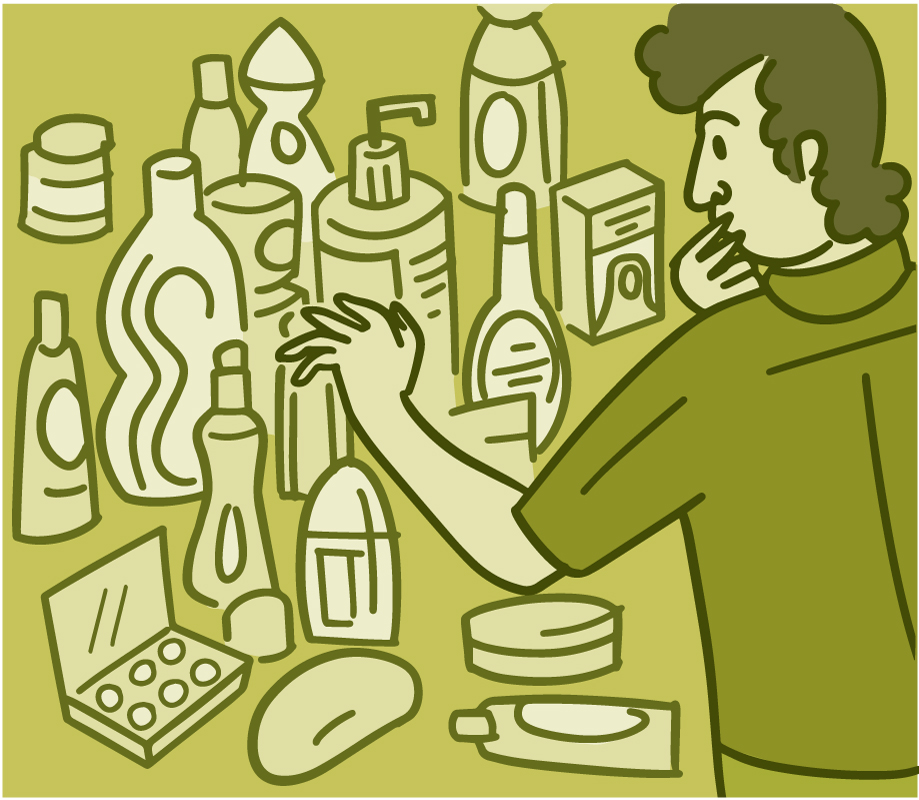Probing Personal Care Products
Look Out for Harmful Ingredients

Shampoo. Shaving cream. Deodorant. Makeup. Hair dye. Perfume and cologne. These and dozens of other products may be in your shower, gym bag, or medicine cabinet. But do you know what’s in them? Could any of their ingredients be risky for your health?
Personal care products, including cosmetics, are regulated by the U.S. Food and Drug Administration (FDA). But they’re not treated like drugs. They don’t have to be approved by the FDA before they go on the market. So companies don’t have to prove that personal care products are safe or effective before selling them, says Dr. Alexandra White, who studies chemicals and health at NIH.
The exceptions are personal care products that treat or prevent health conditions. These must be FDA-approved before they go on the market. Examples include sunscreen and anti-dandruff shampoo.
But overall, “cosmetics are one of the least regulated sets of consumer products out there,” says Dr. Ami Zota, an environmental health researcher at Columbia University. The FDA monitors products for potential safety issues once they’re on the market. It takes action when needed to protect public health.
Researchers are working to better understand the health effects of common ingredients in personal care products. They’re also developing better and faster ways to test such ingredients for safety.
What’s in That Bottle?
Most ingredients in personal care products are in a category known as “generally recognized as safe,” or GRAS, explains Dr. Nicole Kleinstreuer, a computational toxicologist at NIH.
But certain chemicals that may cause health problems can be found in many of these products. How much you’re exposed to is often what makes a chemical harmful. The amount that’s “safe” varies for each.
“The general classes we’re concerned about include phthalates, parabens, PFAS, and metals like lead,” says White.
Other problem chemicals include triclosan and triclocarban. These are included in many personal care products to prevent bacterial and fungal growth.
Many chemicals of concern, including phthalates, parabens, PFAS, and triclosan, are endocrine disruptors. These are compounds that can mimic or interfere with the body’s Substances sent through the bloodstream to signal another part of the body to grow or react a certain way. hormones. They’ve been linked to problems with the brain, development, and reproduction. Some have also been linked to a higher risk of certain cancer types.
Metals like lead and mercury can also be toxic. They can cause damage to the brain. Another ingredient to look out for is formaldehyde. It is found in some hair products or created when hair products are heated. Formaldehyde exposure has been linked with cancer.
Talc is also a common ingredient in cosmetics. “Talc is used in a lot of powders, including face powders,” Zota says. It’s generally recognized as safe by the FDA. But talc can sometimes be contaminated with asbestos, which is linked to cancer. The FDA has been testing for asbestos recently in many talc-containing products.
It can be hard to figure out if a product contains potentially risky ingredients. You can avoid some of these chemicals by looking for them on the product label. But they can have many names and abbreviations. Sometimes the names of specific chemicals don’t appear on the label at all, but they’re still in the product.
“Fragrance is one example,” says Zota. “Something listed as ‘fragrance’ can be a mixture of thousands of chemicals.” Looking for fragrance-free products can help lower your exposure to many unknown ingredients.
Which Chemicals Are Risky?
Most personal care products are mixtures of many different chemicals. This can make it hard to link specific products to health problems. But researchers have found some worrying trends.
“We’ve seen [a link] between frequent hair straightener use and cancer risk,” says White. So far, this has included breast cancer and ovarian cancer. Her team has also found a link between the use of permanent hair dye and breast cancer. The risk was especially high for Black women.
To help make safer products, better tests are needed to understand how chemicals affect the body over the long term. Kleinstreuer is working on a team that’s developing new methods to test chemicals in human cells instead of animals. The tests are like taking a chemical fingerprint, she explains.
First, the team measures changes that happen in cells after they are exposed to chemicals with known effects. Then, they test a new chemical. If it produces changes similar to a known one, scientists can assume it affects the body in a similar way.
“For example, we know excess Heat, swelling, and redness caused by the body’s protective response to injury or infection. inflammation is bad. And we can [measure] cell markers of inflammation. If a chemical causes [those markers] to increase, we know that’s a bad thing,” Kleinstreuer says. Inflammation that lingers over time can cause health problems. Her team hopes to eventually use these types of tests to predict which chemicals may be harmful for long-term exposure.
Her team is also using engineered skin tissue to develop better tests for allergy and irritation. These models are being widely used to predict short-term side effects from chemical exposures, including those in cosmetics.
Buyer Be Aware
Trying to keep potentially risky chemicals out of your daily life can help you and your family stay healthier. But there are times that you may want to be even more cautious. People can be more vulnerable to chemical exposures during certain times in their lives.
One of these is pregnancy, says White. “It’s a time when the breast tissue is going through rapid changes and might be more susceptible to cancer-causing chemicals.”
“Even small levels of some of these chemicals can impact fetal development and growth,” Zota says. Early childhood and puberty are other times when people may be more susceptible to endocrine disruptors, she adds.
If you have questions about any personal care products, talk with your health care provider.
NIH Office of Communications and Public Liaison
Building 31, Room 5B52
Bethesda, MD 20892-2094
nihnewsinhealth@od.nih.gov
Tel: 301-451-8224
Editor:
Harrison Wein, Ph.D.
Managing Editor:
Tianna Hicklin, Ph.D.
Illustrator:
Alan Defibaugh
Attention Editors: Reprint our articles and illustrations in your own publication. Our material is not copyrighted. Please acknowledge NIH News in Health as the source and send us a copy.
For more consumer health news and information, visit health.nih.gov.
For wellness toolkits, visit www.nih.gov/wellnesstoolkits.




